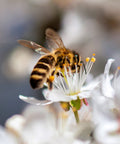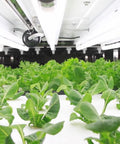
Choosing Between Fresh and Dried Herbs
We all can agree that cooking with any form of herb adds flavor that artificial flavors could never compare to, but have you ever faced the decision of choosing between fresh or dried with utter uncertainty? Well, we're here to educate you on the pros and cons of these different forms of herbs so you can make the right choice every time.
Main Differences
Fresh Herbs:
- Mild flavor (add more)
- Bright color
- Quick infusion time (add near the end of the cooking process)
Dry Herbs:
- Strong flavor (add less)
- Dull color
- Long infusion time (add at the beginning or during the cooking process)
When To Use Fresh Herbs
To get the most flavor out of fresh herbs, it's best to use them near the end of the cooking process as a final step or garnish. Using fresh herbs allows the flavors to release quickly, as opposed to dried herbs which require a longer cooking time for the flavors to fully release. Needless to say, fresh herbs are your best friend when you're pressed for time in the kitchen.
Special dishes and holidays are a great excuse to whip out your skills fresh herb cooking skills to ensure that your dish reaches its max potential with an extra pop of flavor and plate appeal that wows your guests and has them begging for more.




Some of our favorite dishes to add in fresh herbs are: a colorful salad with edible flowers, a soup garnish, sprinkled on fresh cooked chicken or fish, pesto, and herb butters.
When To Use Dried Herbs

Dried herbs are best used at the beginning or during the cooking process so that the flavors have time to release and infuse with your dish. It’s essential to add them in the first few steps, so plan out your flavors ahead of time.
It’s also mentionable to note that some dried herbs don’t retain their flavor as much as others. For example, woody herbs such as rosemary, thyme, and oregano are pretty flavorful when dried, however softer herbs like basil or mint tend to lose a decent amount of flavor once dried.
Contrary to popular belief - dried herbs don't have a long shelf life either; they actually lose their flavor sitting in your spice cabinet over time - so make sure to smell and taste your dried herbs before adding them to your dish, and replace unused herbs about once a year.




Some of our favorite dishes to add dried herbs are: roasted veggies, herb rubs, homemade seasonings, and dipping oils.
Substituting One for the Other

If you need to substitute dried herbs for a recipe that calls for fresh herbs, here's a handy rule:
3:1 Ratio : 1 tsp Dried = 1 Tbsp Fresh
(FYI there are 3 teaspoons in 1 Tablespoon if your kitchen math is a little rusty)
So if a recipe calls for 2 tbsp of fresh chopped basil, add 2 tsp of dried basil, or 1/3 the amount of fresh herbs called for (there are 6 tsp in 2 Tbsp, so divide 6 tsp by 3 and you arrive at 2 tsp).
This same rule works for the opposite - if you're growing fresh herbs and can't even stand the thought of using dried herbs anymore, just use 3x the amount of fresh herbs that a dried herb recipe would call for.
Tips When Using Fresh Herbs

1. Unless you’re growing indoors year-round in your ēdn SmallGarden or windowsill, fresh herbs aren’t always at your fingertips. Fresh herbs will start losing flavor after 2-3 days of being cut (so keep this in mind when picking up herbs at your local grocery - maybe even opt for buying fresh from your local farmer’s market.
2. Fresh herbs have a lighter flavor than dried herbs, so make sure to use more fresh herbs in a recipe than you would dried herbs.
3. The thickness of fresh herbs greatly affects its flavor strength, so ensure that you use thicker herbs sparingly, chop them finely, or take them out of a dish prior to serving to ensure that the flavor isn’t overpowering.
4. Tender herbs like basil should be finely chopped and added at the end of cooking a warm dish to prevent your herb from wilting. If you want to top off your margherita pizza with fresh basil - add it about 5 minutes after taking your 'za out of the oven for maximum freshness and flavor.
Keeping Your 'Fresh' Herbs Fresh

There are many benefits of growing your own indoor herb garden, such as having fresh herbs on-demand conveniently on your countertop all year, but if you must buy fresh herbs from the store rather than growing your own herbs, here’s some tips for getting the best out of your store-bought herbs:
Purchasing
- Buy them as close as possible to the time you are going to use them
- Look for a strong aroma and bright leaves
- Avoid herbs with discoloration or limp and soggy leaves
Prepping
- Take off any ties or rubber bands that could bruise your herbs
- Cut off the root ends so they don't draw moisture from the leaves
- Rinse in cold water and pat dry
Storing
- Wrap in a slightly damp paper towel or wash cloth and put in a zip lock baggie
- Put them in the warmest part of the refrigerator like a crisper drawer
- Don't remove them from the refrigerator until they are ready for fresh use
The Verdict

There's no right or wrong when deciding between fresh or dried herbs, however we recommend if you grow it, show it ; )
Growing your own herbs in your ēdn SmallGarden or your DIY urban garden makes it easy to have fresh herbs at your fingertips. You don't need to worry about timing your grocery store trips, washing you herbs, or storing the fragile fresh-cut sprigs. Not to mention, you're saving money and reducing your carbon footprint with less food miles and zero single use packaging used.

This isn't a diss at our old trusty dried herbs tucked away in our cabinets - they've saved us all a countless number of times and still know how to pack a punch when needed. Choose which method works best for you and your dish, or even mix the two for an explosion of flavor.
If you want to give more life to your fresh herbs, check out our post on how to preserve your herbs - by freezing them or drying them with a few simple steps!








